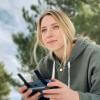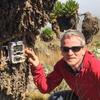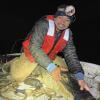Wildlife tracking technologies have already massively advanced our understanding of the natural world, from uncovering previously mysterious migration patterns and key movement corridors to demonstrating the impacts of anthropogenic pressures and climate change. Recent advances in the development of technologies for collecting and transmitting biologging data have unlocked the potential for fine-scale data collection at a near-global scale, which when integrated with remotely sensed environmental data offers an unprecedented biological lens into ecosystem health and environmental change (Jetz et al. 2022).
New technologies on the horizon include small satellites like CubeSats, which are being investigated by NASA, the ICARUS Initiative's satellite system, and a variety of other ventures aiming to improve the coverage, accuracy, and capacity of wildlife tracking data collection. Combined with the increased availability of high-resolution environmental data and analytical developments in movement modeling, these advancements are empowering movement ecologists to ask previously unanswerable or unimaginable questions. It’s clear that this discipline sits at the precipice of major breakthroughs that could revolutionize our understanding of animal movement and the natural world.
Arribada Initiative
Director at Arribada, a UK-based conservation technology research & development organisation



- 2 Resources
- 95 Discussions
- 11 Groups
- 0 Resources
- 0 Discussions
- 5 Groups
Spanish veterinarian interesting wildlife conservation
- 0 Resources
- 0 Discussions
- 9 Groups
Aarhus University
Biologist and Research Technician working with ecosystem monitoring and research at Zackenberg Research Station in Greenland





- 12 Resources
- 215 Discussions
- 7 Groups
- 0 Resources
- 0 Discussions
- 7 Groups
- @TaliaSpeaker
- | She/her
WILDLABS & World Wide Fund for Nature/ World Wildlife Fund (WWF)
I'm the WILDLABS Research Specialist at WWF-US



- 12 Resources
- 54 Discussions
- 24 Groups
Prof at NC State University and Scientist at NC Museum of Natural Sciences



- 1 Resources
- 19 Discussions
- 4 Groups
Sustainability Manager for CERES Tag LTD. An animal health company; animal monitoring, conservation, & anti-poaching/ rural crime. Wildlife, livestock, equine & companion. #CeresTrace #CeresWild #CeresRanch




- 2 Resources
- 19 Discussions
- 24 Groups
Worked as a mechanical engineer for a defence co, then software engineer, then for a research lab specialising in underwater robotics.



- 1 Resources
- 135 Discussions
- 16 Groups
I am biologist, I have studied wild life and ethnobiology at Amazon and caimans in Brazil
- 0 Resources
- 0 Discussions
- 10 Groups
- @tutgut5
- | she/her
- 0 Resources
- 5 Discussions
- 8 Groups
- @tve
- | he
techie
- 0 Resources
- 1 Discussions
- 2 Groups
Careers
The Smithsonian National Zoo & Conservation Biology Institute is seeking a Program Manager to help coordinate multiple organizations in an effort to integrate movement data & camera trap data with global...
22 April 2024
The Smithsonian National Zoo & Conservation Biology Institute is seeking a Postdoctoral Research Fellow to help us integrate movement data & camera trap data with global conservation policy.
22 April 2024
Article
You’re invited to the WILDLABS Variety Hour, a monthly event that connects you to conservation tech's most exciting projects, research, and ideas. We can't wait to bring you a whole new season of speakers and...
22 March 2024
Hussey Labs seeks a senior post-doctoral researcher/senior research associate for movement ecology of Greenland halibut in the context of fisheries management across Baffin Bay-Davis Strait, Eastern Canadian Arctic.
13 March 2024
Catch up on the conservation tech discussions and events that happened during World Wildlife Day 2024!
7 March 2024
more affordable pricing for our software for the visualization and annotation of GPS and acceleration data
4 March 2024
Careers
Seeking a doctoral student to join the Move.inFormation research group in an exciting new project investigating the use of social information for optimal movement in the Andean condor.
12 February 2024
Research topic: Pathogens and predators represent the ultimate and ubiquitous threats to fitness. One of the defense counter-strategies is behavioural avoidance of the cues of infection risk (disgust) and predation risk...
10 February 2024
The primary focus of the research is to explore how red deer movements, space use, habitat selection and foraging behaviour change during the wolf recolonization process.
10 February 2024
The Wildlife Restoration Foundation is hiring a Conservation Technology Intern
8 February 2024
In the last article of my series examining how people find biologging tech for their projects, I spoke with Annkathrin Sharp, a Programme Officer at Fauna & Flora about how her experience choosing DIY Biologgers to...
14 December 2023
In the penultimate article in my series examining how people find biologging tech for their projects, I spoke with Matthew Stanton about developing custom biologging technology for studying koala behaviour.
7 December 2023
June 2024
event
April 2024
event
March 2024
event
| Description | Activity | Replies | Groups | Updated |
|---|---|---|---|---|
| Thanks, Thomas! I will definitely look into this more. I like the idea of finding ways to adjust the base plate/attachment point to something more biodegradable/sustainable, so... |
|
Biologging, Marine Conservation | 2 hours 24 minutes ago | |
| I am working on that too haha. So in my design you load the glue gun with two part Loctite, it has two separate metal rings. Glue and hardener in each ring. Then each ring has a... |
+23
|
Biologging | 3 days 12 hours ago | |
| I'll find you some. Just organising all of our stock of these. |
+9
|
Biologging | 6 days 5 hours ago | |
| Hi everyone, @craig joined last month's Variety Hour to chat about Tagranger, which you can read more about here. A TagRanger®... |
|
Biologging, Connectivity, Sensors | 1 week 1 day ago | |
| 'Most importantly, we have to make it play a MIDI version of the DoctorWho theme song when you arm the device. That has to be the #1 feature if you ask me!' Seconded! |
+9
|
Acoustics, Biologging, Emerging Tech, Open Source Solutions, Sensors | 1 week 2 days ago | |
| Might very well be so! I highly encourage you to take up the challenge! |
+23
|
Biologging | 1 week 5 days ago | |
| This is so cool @Mauricio_Akmentins - congrats and look forward to seeing your project evolve! |
|
Acoustics, Biologging, Climate Change, Conservation Tech Training and Education, Data management and processing tools, Emerging Tech, Open Source Solutions, Protected Area Management Tools, Sensors, Software and Mobile Apps | 2 weeks 3 days ago | |
| You mention you're working with an engineer, here are a couple of pointers:with an SDR (the "digital USB receivers" you mention) you can scan some bandwidth to detect radio pulses... |
|
Biologging, Build Your Own Data Logger Community | 2 weeks 6 days ago | |
| Hello everyone, I'm interested in gathering insights on how the behavior of different species impacts the development and efficacy of... |
|
Biologging, Acoustics, Camera Traps, eDNA & Genomics, Emerging Tech, Marine Conservation | 1 month ago | |
| Hello Peter, Have you find a solution ? I will be happy to discuss with you about your project and field challenges ? Best,Virginie |
+26
|
Biologging | 1 month ago | |
| Thank you Carly, I will definitely take a look. |
|
Acoustics, Biologging, Climate Change, Conservation Tech Training and Education, Data management and processing tools, Remote Sensing & GIS, Software and Mobile Apps | 1 month ago | |
| Hi all, I am searching for marine species projects that monitor orientation/IMU and/or acceleration data... |
|
Biologging, Marine Conservation | 1 month 1 week ago |
Passionate engineer offering funding and tech solutions pro-bono.
23 January 2024 12:06pm
2 February 2024 1:22pm
Hi Danilo. you seem very passionate about this initiative which is a good start.
It is an interesting coincidence that I am starting another project for the coral reefs in the Philipines which also requires water analytics so I can probably work on both projects at the same time.
Let's that have a call and discuss, will send you a pm with my contact details
There is a tech glitch and I don't get email notifications from here.
Questions regarding the use of solar panels to extend battery life of GPS collars
6 January 2024 8:44pm
24 January 2024 10:45am
With a Vectronic Vertex Plus 2D collar, 32Hz 3D acceleration and 15min position fix intervals you can expect between 3-6 months of lifetime using Iridium as position transfer.

This project seem to be using both 2D and 3D sized collars on lions:
https://www.vectronic-aerospace.com/projects/#KopeLion
28 January 2024 10:27pm
Lars,
As always, your insights are great! The GPS Plus X battery life calculator is great! I've downloaded it and have been toying around with it, very convenient when thinking about sampling schedules. Curious as to why more tech developers don't incorporate something similar into their own programming/analysis software. Very useful.
I've got a few meetings set up with a couple different tech developers, but may reach to Vectronic here. At first glance, their collars seem great! I appreciate the recommendations.
I must admit, I am not well versed in Python, but I am looking into something that wold be the R equivalent. If I don't have much luck, I may try and take a look at how that package was made in Python and attempt to recreate it in R.
You're the best Lars! Thanks!
Cheers,
Travis
28 January 2024 10:42pm
Hi Bill,
I don't believe I will need them to be extremely accurate, but will need a good degree of accuracy for some behavioral classification and habitat use analyses. In regards to the solar, tracking the solar cycle is a great suggestion. I have also considered having some thresholds programmed in the accelerometer to power off both sensors during periods of sleep/rest in order to conserve battery life. I did this same thing in my last study for the GPS only, so there wouldn't be instances where the trackers continued to try and unsuccessfully acquire GPS fixes while the bats where inside their caves resting. After the bat's surge axis dropped into the -1 and there was 10 unsuccessful GPS fix attempts in a row, the GPS powered down.
Thanks for the suggestions and insights Bill!
Best,
Travis
Cat Island, Bahamas biologger recovery
7 December 2023 9:57pm
12 January 2024 4:07pm
Were you guys able to recover the tag? @Alasdair
17 January 2024 6:05pm
Hi Alasdair,
I am also curious with the result, were you able to recover the tag? Also is there any that ended up in Indonesia sea? We would love to help the recovery if any.
Cheers,
Dhanu
23 January 2024 2:37pm
Hi @ThomasGray_Argos, @YvanSG and @hjayanto,
Thank you all for getting in touch. Luckily the Cat Island Institute via YME Bahamas got in touch and prepared an expedition to recover it. They couldn't access the beach during the first attempt, but a second attempt is planned. I'll hopefully be able to recover it shortly.
Thanks again,
Alasdair
Open-source kinetic energy harvesting collar - Kinefox
1 November 2023 5:31pm
17 January 2024 7:45pm
This is super cool!
I was wondering if the development will further touch marine or aquatic animals, make it like water wheel (even might give burden to aerodynamic). Thank you for sharing!
Best,
Dhanu
20 January 2024 7:16am
Not a water wheel but equally cool.
20 January 2024 9:10pm
Super cool! thank you for sharing!
How to build my VHF tags from the scratch?
9 January 2019 10:04am
29 December 2022 10:43am
@Tinytx Hello I am interested in details please contact me by email [email protected] thank you
12 January 2024 11:07am
@Tinytx Hi, I am very interested in detail regarding this transmitter, would you mind sharing the information you have, [email protected]
Many thanks
Sam
12 January 2024 1:25pm
Wow! So impressive! Being old enough to precede the existence of personal computers these are the things of my dreams back then :)
What is your favorite package or software for visualizing animal tracking data?
12 September 2023 6:52pm
29 December 2023 11:09pm
30 December 2023 2:32pm
It was indeed recorded and can be viewed here:
Data Viz Inspo for the Holidays: December 20, 2023 (youtube.com)
Cheers,
Lars
31 December 2023 8:03pm
Appreciate that Lars!
Semi-automated prediction of behavioral states in wild understudied King vultures (Sarcoramphus papa)
20 December 2023 1:34pm
For the current e-obs newsletter, Chris Beirne and I have summarized our previous work on the annotation of King vultures in Costa Rica.
Seeking Host Organisations for Travel Scholarship Application
19 December 2023 12:54am
20 December 2023 3:07am
Hi Eva,
Me and my colleagues run a small NGO based on Yogyakarta in Indonesia, although our projects are spread around the country. One of our active project is working with the movement ecology of Sunda gharials in Berbak-Sembilang National Park. One of the other is for Malayan Giant Turtle conservation using one-plan approach, which we are planning to start in situ phase. We can't give you promise about anything, but are able to be the host organization and would love to talk the opportunity!
Cheers,
Dhanu
Which market-available microphones, accelerometers and GIS sensors for dogs / pets ?
7 September 2023 3:21pm
6 December 2023 2:03pm
good to know that GPS coordinates can be used to sync the time.
Does GPS resolution allow to a desired time resolution (e.g. seconds) ? Does choice of time resolution significantly depends on the physiology of the animal (e.g. time of re-action to stimuli, hence less than a second) or for most animal communication and animal behaviour is it enough above a second?
7 December 2023 7:03am
Hi Luigi!
It is not the coordinates but the information from the "pulse per second" from the GPS which is used for the time sync.
Have a look at
17 December 2023 3:02pm
I am not an acoustics person but train and deploy canines in the field. Are you looking for something that records sniff rate and patterns? For GPS I just use a Garmin collar system Altha 100. There is a Conservation Canine group that might be worth asking your question in.
Bear-dar: Updates from the Field
15 December 2023 11:58am
Polar Bear International chat about bear-dar and burr on fur in this video on Youtube
https://www.youtube.com/watch?v=AfL42Wqctkk
How to Choose a Biologger - Mapping Goat Movement with Annkathrin Sharp
14 December 2023 3:34pm
Data Viz Inspo December 20th
12 December 2023 12:03pm
Data Viz Inspo for the Holidays
11 December 2023 8:42pm
How to Choose a Biologger - Collaring Koalas with Matthew Stanton
7 December 2023 12:00pm
12 December 2023 5:22pm
13 December 2023 10:06pm
Query regarding Biologgers for Freshwater crabs
16 November 2023 4:45am
18 November 2023 10:37pm
My pleasure @Abinesh and if you have any more questions etc., don't hesitate to ask. This is a great community with plenty of smart cookies that can help and also me if I am able!
All the best for your research.
Rob
1 December 2023 8:54pm
Star-Oddi in Iceland comes to mind, but I'm not 100% sure.
3 December 2023 2:43am
Thank you Thomas, you are absolutely right but when I Mailed them, I didn't get a response about the price , shipment and so on! Thus I arrived to find some loggers in India itself
Alternative trackers for study of grey parrots movement patterns
3 November 2023 7:31pm
24 November 2023 9:18am
Hi Thomas thank you for your recommendation.
Yeah getting an appropriate tag for the parrots has really been challenging
24 November 2023 9:20am
Hi Rob,
thank you for the recommendations. I will checkout both options and choose the one which will be well suited for my zone of studies.
Warm Regards, Benedicta
1 December 2023 8:10pm
Hi Ninying,
One benefit of the Pinpoint tags is that they are user-rechargeable, something pretty much unheard of for satellite tags for decades! If you can recover the tags, you might be able to achieve a larger samples size with fewer tags (less $$) by redeploying the recovered tags - without the costs of having the manufacturer refurbish them.
cheers,
Kyler
How to Choose a Biologger - Marine animals with Samantha Andrzejaczek, Jessica Rudd and Lucy Hawkes
30 November 2023 12:03pm
Automatic and open-source radio-tracking
15 November 2023 10:03am
20 November 2023 10:39am
Thanks for the information, I'm going to have a look and will keep you updated if I got any news.
23 November 2023 4:58pm
Hi @tutgut5 @Rob_Appleby
their system has been used in a research project at the University of Marburg (LOEWE-Schwerpunkt Natur 4.0), its also been used in combination with Infra-red videos of bat movements (BatRack). We cooperated with them in 2021 for a small telemetry study, it worked well for us, here is their homepage
(although I'm not sure how up to date it is), if you have questions and would like some more info about their system there is an email address to contact them at.
All the best,
Sarah
24 November 2023 6:22am
Thanks for the information @Sarita , very helpful indeed!!
Cheers,
Rob
ICOTEQ launch TAGRANGER® system of products
23 November 2023 1:25pm
How to Choose a Biologger - Tracking Endangered Seabirds with Yvan Satgé
23 November 2023 12:10pm
Firetail - Black Friday
Animove 2024
17 November 2023 10:47am
Catch up with The Variety Hour: November 2023
16 November 2023 12:59pm
How to Choose a Biologger - Tracking Elephants with Neus Estela Ribera
16 November 2023 12:01pm
How to Choose a Biologger - Where do I start?
16 November 2023 12:00pm
TWS2023 - get in touch
5 November 2023 8:13pm
5 November 2023 9:04pm
I'm registered with the TWS2023 app, so feel free to nudge me there as well
Digital Signals Processing - free online textbook
31 October 2023 1:50pm
I just discovered this freely available book on digital signal processing and love the fact that it is“…intended for students … who may not have much mathematical or engineering training.” Seems like a great resource for bioacoustics, biologing etc!
Movebank tutorial on uploads of tag acceleration and magnetometer data
27 October 2023 2:14pm
5 Trailblazing Wildlife Monitoring Tech Solutions across East Africa. What Monitoring Technologies are you using?
25 October 2023 12:40pm





























































26 January 2024 3:18pm
Hi Krasi! Greetings from Brazil!
That's a cool journey you've started! Congratulations. And I felt like theSearchLife resonates with the work I'm involved round here. In a nutshell, I live at the heart of the largest remaining of Atlantic forest in the planet - one of the most biodiverse biomes that exist. The subregion where I live is named after and bathed by the "Rio Sagrado" (Sacred River), a magnificent water body with a very rich cultural significance to the region (it has served as a safe zone for fleeing slaves). Well, the river and the entire bioregion is currently under the threat of a truly devastating railroad project which, to say the least is planned to cut through over 100 water springs!
In face of that the local community (myself included) has been mobilizing to raise awareness of the issue and hopefully stop this madness (fueled by strong international forces). One of the ways we've been fighting this is through the seeking of the recognition of the sacred river as an entity of legal rights, who can manifest itself in court, against such threats. And to illustrate what this would look like, I've been developing this AI (LLM) powered avatar for the river, which could maybe serve as its human-relatable voice. An existing prototype of such avatar is available here. It has been fine-tuned with over 20 scientific papers on the Sacred River watershed.
And right now myself and other are mobilizing to manifest the conditions/resources to develop a next version of the avatar, which would include remote sensing capacities so the avatar is directly connected to the river and can possibly write full scientific reports on its physical properties (i.e. water quality) and the surrounding biodiversity. In fact, myself and 3 other members of the WildLabs community have just applied to the WildLabs Grant program in order to accomplish that. Hopefully the results are positive.
Finally, it's worth mentioning that our mobilization around providing an expression medium for the river has been multimodal, including the creation of a shortfilm based on theatrical mobilizations we did during a fest dedicated to the river and its surrounding more-than-human communities. You can check that out here:
Let's chat if any of that catches your interest!
Cheers!